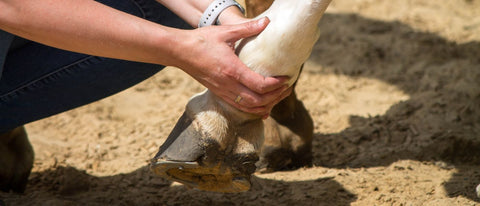
Florian ist aufgewachsen auf einem Bauernhof. Umgeben von Pferden, entdeckte er früh seine Faszination für diese majestätischen Tiere. Inspiriert von seiner reitbegeisterten Mutter, entwickelte er das Nahrungsergänzungmittel - Pferdegold. Seine tiefe Verbundenheit zur Natur und die leidenschaftliche Hingabe zu Pferden trieben ihn an, sein Unternehmen zu gründen.
Do you know this feeling? Your horse seems unwilling, his movements are restricted, and he seems unable to use his hindquarters properly.
The cause can often be an SI joint blockage. This problem affects the sacroiliac joint—a key element for your horse's mobility and performance.
In this guide, you will learn everything you need to know about the sacroiliac joint in horses, the typical symptoms of a blockage, and how you can effectively counteract it.
This gives you the chance to help your faithful companion in the best possible way and ensure his well-being.

What is the function of the sacroiliac joint in horses?
The sacroiliac joint ( SI joint ) plays a central role in the physical integrity and movement of your horse .
As a connecting element between the spine and hindquarters, the sacroiliac joint transfers the force from the horse's hind legs to the rest of the body.
This joint allows the horse to make effective and fluid movements , which are essential for all activities, from leisurely riding to demanding jumping .
A dysfunction in this area, such as an ISG blockage , can therefore have far-reaching consequences for the mobility and well-being of your horse.
That is why the ISG is crucial for the power transmission of the hindquarters
The sacroiliac joint is crucial for the transmission of power to the horse's hindquarters .
It acts as a central hub that absorbs the energy and power of the hind legs and transmits it to the rest of the body.
Imagine the sacroiliac joint as a kind of joint bridge that allows the horse to use its full power efficiently and in a coordinated manner.
The sacroiliac joint plays a key role, especially in fast or powerful movements such as galloping or jumping .
A well-functioning sacroiliac joint mechanism is therefore essential for the horse's athletic performance and general well-being .
Blockages or dysfunctions in this area can significantly impair mobility and should therefore be detected and treated early.
Where is the sacroiliac joint (SI joint) located?
The sacroiliac joint, or SI joint for short, is located in a central, yet not immediately visible, area of the horse's body. The question " Where is the sacroiliac joint? " therefore leads us deep into the horse's anatomy : The SI joint connects the sacrum, part of the spine, with the two iliac bones of the pelvis.
Located in the area of the croup, the sacroiliac joint is not directly visible from the outside, but its position can be located approximately where the zipper of a human trouser pocket ends.
Despite its hidden location, it is of central importance for the horse's mobility and health.
Symptoms & first signs of a blocked hip
When a horse's hip is blocked, there are often clear symptoms that may indicate a problem in the sacroiliac joint.
Early detection of these signs is crucial to intervene in time and avoid further complications .
-
Lameness: One of the most common signs of a sacroiliac joint blockage is an unexplained lameness in the hindquarters. Your horse may move stiffly or show difficulty in evenly weight-bearing his hind legs.
-
Limited movement: Watch for signs of reduced mobility. Your horse may have difficulty bending, turning, or performing certain movements that he normally performs without difficulty.
-
Altered posture: A change in posture is often observed. The horse may try to compensate for the pain by adopting an unusual posture, resulting in asymmetrical loading.
- Behavioral changes: Your horse may also exhibit behavioral changes, such as irritability or a decreased willingness to cooperate. This could be an indication that he is in pain.

What kind of pain can be caused by the sacroiliac joint?
Pain caused by problems with the sacroiliac joint can be varied and sometimes difficult to localize.
They often manifest themselves in the form of deep, pulling pain in the croup area , which can spread to the hind legs.
This pain significantly impairs the horse's mobility, which manifests itself in reduced performance and a limited ability to move smoothly.
In some cases, the pain may be so severe that it causes a significant change in the horse's behavior , such as increased sensitivity or aggressiveness when touching the affected area.
It is important to take these symptoms seriously and consult a veterinarian or qualified therapist immediately to ensure adequate treatment for your horse.
All causes at a glance
Sacroiliac joint (SI joint) blockage in horses can be caused by various factors. It is important to understand the possible causes in order to take preventative measures and, if necessary, to provide targeted treatment.
-
Trauma: A common trigger for sacroiliac joint problems is trauma. This can occur from accidents such as falls or collisions while riding, galloping, or handling in the paddock .
Such events can lead to direct injuries to the joint or to indirect damage through overstretching and straining of the surrounding muscles and ligaments.
As a result, inflammation and pain in the sacroiliac joint area can occur, which severely impairs the horse's well-being and mobility.
-
Incorrect training: Inappropriate or too early training can also lead to problems in the sacroiliac joint.
Especially young horses, whose bodies are not yet fully developed, can suffer damage to the sacroiliac joint if training is too intensive or incorrect .
Exercises that place excessive strain on the hindquarters or require premature collection can disrupt the natural development of the joint and lead to long-term health problems.
-
Incorrect riding: Not only training, but also daily riding has a major influence on the health of the sacroiliac joint.
An unbalanced seat, inconsistent rein control or inappropriate loading of the hindquarters can lead to uneven strain on the sacroiliac joint .
This can lead to tension, incorrect loading, and, subsequently, blockages in the sacroiliac joint. Continuous, incorrect riding can thus cause permanent impairment of the sacroiliac joint and associated pain for the horse.
Treatment: What really helps?
When treating an SI joint blockage in horses, a comprehensive approach is crucial.
The solution of the sacroiliac joint in horses often requires a combination of manual therapy, drug treatment and specific exercises .
An experienced veterinarian or equine physiotherapist can use techniques to release the horse's sacroiliac joint and thus improve mobility.
In addition to the direct treatment of the joint, it is important to strengthen the surrounding muscles and relieve tension.
Sacroiliac joint treatment in horses may also include anti-inflammatory medications and painkillers to relieve discomfort and support the healing process . Regular follow-up checkups and a customized training routine help keep the horse's sacroiliac joint healthy over the long term.
Can gymnastics strengthen the sacroiliac joint in horses?
Yes, targeted gymnastics exercises can make a significant contribution to strengthening the horse's sacroiliac joint and releasing blockages.
Exercises that specifically aim to strengthen and stretch the muscles around the sacroiliac joint are considered particularly effective.
Helpful sacroiliac joint exercises for horses to release blockages include controlled bends, lateral movements and gentle stretching movements.
These exercises not only promote mobility in the sacroiliac joint, but also contribute to the horse's general fitness and balance.
Caution : It is important to perform such exercises regularly and under professional supervision to achieve optimal results and minimize the risk of injury.

Responsible diagnostic practice: Why you should avoid hasty (fashion) diagnoses
A responsible diagnostic practice is crucial to ensure the correct treatment for a blocked hip in the horse.
It is important not to make a diagnosis too quickly, as the symptoms of an SI joint blockage can also indicate other diseases .
A careful examination by a qualified veterinarian is essential to obtain a correct and comprehensive diagnosis.
Hasty or fashionable diagnoses can lead to inappropriate treatments that can be not only ineffective but also harmful to your horse.
A thorough medical history, clinical examination and, if necessary, imaging procedures such as X-rays or MRI are necessary to determine the exact cause of the symptoms.

Pferdegold® supplementary feed!
Pferdegold is a small family business from Bavaria with a big dream: to produce the best horse feed. We see ourselves as a family of equestrians who want to provide your horse with the ideal nutrition. 100% natural and perfectly tailored to your horse's needs.
Try it now!What are the consequences of a blocked hip in a horse?
A blocked hip in a horse can have far-reaching and serious consequences for the animal's health and behavior . Initially, it leads to impaired mobility, which can manifest itself in reduced performance and difficulties with dressage exercises or jumping.
In the long term, an untreated blockage of the sacroiliac joint can lead to chronic pain, muscle tension and asymmetrical strain on the musculoskeletal system .
This can result in uneven muscle development, making the horse more susceptible to further injuries.
In addition, the horse's behavior may change; it may become irritated or reluctant , especially when being saddled or ridden.
Therefore, it is crucial to recognize symptoms early and treat them appropriately to avoid long-term damage and pain for your horse.

Conclusion
In this guide, we've seen how complex the sacroiliac joint is and the important role it plays in your horse's life. From the correct diagnosis of a blocked hip to treatment and prevention, every step counts to ensure your horse has a healthy and active life.
Remember that prevention, regular checkups, and proper training are key to protecting your horse from long-term sacroiliac joint problems.
With patience and commitment, you have a good chance of ensuring that your horse can enjoy its full freedom of movement.
IMPORTANT :
Pferdegold is not a substitute for veterinary diagnosis or treatment . The information contained in this article is for general informational purposes only and is intended to help improve your horse's well-being.
Pferdegold products do not treat or cure diseases , but rather support your horse in correcting nutritional deficiencies through targeted nutrient intake. However, they are not a substitute for professional advice from a veterinarian or specialist.
If your horse has any health problems , we strongly recommend consulting a veterinarian . Pferdegold assumes no liability for decisions made based on the information provided here.
FAQ
How long does it take to resolve an ISG blockage?
The time it takes to release an SI joint blockage in a horse varies depending on the severity of the blockage and the individual horse.
Typically, significant improvement can be expected within a few weeks to a few months, provided treatment is carried out consistently and professionally.
It is important to be patient and support the healing process with regular check-ups and appropriate care.
How can I protect my horse's hips from blockages?
To protect your horse's hips from blockages, it's important to ensure balanced training and regular, appropriate exercise. Ensure proper saddle fitting, avoid overloading, and promote flexibility and strength through targeted training and stretching exercises.
Regular checkups by a veterinarian or therapist can help identify and prevent problems early.
Can a hip blockage in horses go away on its own?
In mild cases, a hip blockage in horses can sometimes resolve itself, especially if it was caused by temporary overload or minor tension.
However, if symptoms persist or problems recur, it is advisable to consult an expert.
In most cases, professional treatment is necessary to ensure full mobility and avoid long-term damage.
Learn more about horse health and discover our next guides!

















